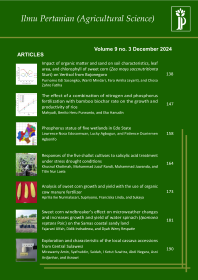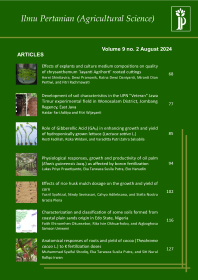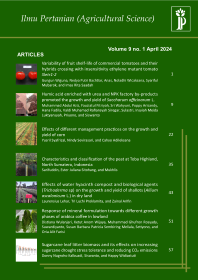Proline Activity and Growth of Oil Palm affected by Aluminium Toxicity and Silica as Ameliorant
Annisa Khoiriyah(1*), Eka Tarwaca Susila Putra(2), Prapto Yudono(3)
(1) Department of Agronomy, Faculty of Agriculture, Universitas Gadjah Mada
(2) Department of Agronomy, Faculty of Agriculture, Universitas Gadjah Mada
(3) Department of Agronomy, Faculty of Agriculture, Universitas Gadjah Mada
(*) Corresponding Author
Abstract
The research aims to investigate the effects of silica (Si) as an ameliorant on the proline compound concentration and the growth response of oil palm exposed to aluminum toxicity. The research was arranged in a complete randomized block design with 8 blocks as replications. The first factor was Al toxicity which consisted of two levels as without and with Al toxicity. Al toxicity treatment was applied by giving 300 ppm of Al concentrate along with watering activity regularly. The second factor was the application of silica which consisted of four levels as 0, 32, 64 g/plant. Proline and growth activities of leaf area, plant height, number of leaves, and dry weight were observed in the research. The data subjected to analysis of variance (ANOVA) at 5% test level. If the result of ANOVA showed significant differences among treatments, then the data would have been analyzed by Duncan’s Multiple Range Test (DMRT) at 5% test level. The results of the research provide information that Al toxicity increases proline compound in the plant tissues and decreases leaf area, plant height, number of leaves, and dry weight of Oil Palm. Applying Si at the level of 64 g/plant could increase proline concentrate and dry weight of oil palm exposed to A1 toxicity. Proline compound in the plant tissues did not have any correlation with the growth of oil palm. Thus, this case indicated that proline was a product and not a plant tolerant mechanism of Al toxicity.
Keywords
Full Text:
PDFReferences
Ashraf, M & M.R. Foolad. 2007. Roles of glycine betaine and proline in improving plant abiotic stress resistance. Environmental and Experimental Botany 59 : 206-216.
Çelik, Ö. & Ç. Atak. 2012. The effect of salt stress on antioxidative enzymes and proline content of two Turkish tobacco varieties. Turk J. Biol. 36: 339-356.
Clarkson, D.T. 1969. The effect of Aluminium and some other trivalent metal ions on the cell division in the root of Allium cepa. Ann. Bot. 20 : 309-315.
Enggarini, W & E. Marwani. 2006. Pengaruh cekaman aluminium terhadap kandungan asam organik dalam kalus dan pinak tomat (Lycopersiconesculentum Mill.). JurnalAgroBiogen2 : 24-28
Galvez, L & R.B. Clark. 1991. Effects of silicon on growth and mineral composition of sorghum (Sorghum bicolor) grown with toxic levels of aluminium. Dalam Plant-Soil Interactions at Low pH, Proceedings of the Second International Symposium on Plant Soil Interactions at Low pH, Kluwer Academic Publisher, Beckley, WV. June 1990. 815-823.
Hamim, D., Sopandie& M. Yusuf. 1996. Beberapa karakteristik morfologi dan fisiologi kedelai toleran dan peka terhadap cekaman kekeringan. Hayati3 : 30 - 34.
Hanum, C., W. Q. Mugnisjah, S. Yahya, D. Sopandie, K. Idris & A. Sahar. 2009. Penapisan kedelai toleran cekaman aluminium dan kekeringan. Forum Pascasarjana32 : 295-305.
Huang, P.M., A. Violante. 1997. Pengaruh asam organik terhadap kristalisasi dan sifat permukaan produk pengendapan Al. In : P.M. Huang, M. Schnitzel (Eds). Interaksi Mineral Tanah denganOrganikAlamidanMikroba.UGM Press. Yogyakarta
IMA (Indonesian Ministry of Agriculture). 2010. Area and Production by Category of Producers: Palm Oil, DirektoratJenderal Perkebunan. KementerianPertanian. http://ditjenbun.deptan.go.id/index.php /direktori/3-isi/4-kelapa-sawit.html. (Diaksestanggal 26 Agustus 2015).
Jain, M., G. Mathur, S. Koul& N. B. Sarin. 2001. Ameliorative effects of prolin on salt stress-induced lipid peroxidation in cell lines of groundnut (Arachishypogeae L.). Plant Cell Rep 20 : 463-468.
Matichenkov, V.V & D.V. Calvert. 2002. Silicon as beneficial element for sugarcane. Journal Society of Sugarcane Technologiest22 : 21-30.
Rengel, Z. 1997. Role of calcium in aluminium. New Phytol 21: 499 – 513.
Risza, S. 2008. Kelapa Sawit dan Upaya Peningkatan Produktivitas. Penerbit Kanisius. Jakarta
Rorison, J.W. 1973. The effect of acidity on the nutrient uptake and physiology of plants. In Dost1 : 223-254.
Salisbury, F.B. & C.W. Ross. 1995. FisiologiTumbuhan (diterjemahkan oleh Lukman dan Sumaryono). ITB. Bandung.
Savant, N. K, G.H. Korndorfer, L.E. Datnoff& G.H. Snyder. 1999. Silicon nutrition and sugarcane production : a review. Journal Plant and Nutrition 22 : 1853-1903.
Shahnaz, G., E. Shekoofeh, D. Kourosh& B. Moohamadbagher. Interactive effects of silicon and aluminum on the malondialdehyde (MDA), proline, protein and phenolic compounds in Boragoofficinalis L. Journal of Medicinal Plants Research 5 : 5818-5827.
Umebese, C.U., T.O. Olatimelitin& T.A. Ogunsusi. 2009. Salicylic acid protects NR activity, growth and proline in amaranth and tomato plants during water deficit. American Journal of Agr.& Biological Sciences 4 : 224-229.Article Metrics
Refbacks
- There are currently no refbacks.
Ilmu Pertanian (Agricultural Science) ISSN 0126-4214 (print), ISSN 2527-7162 (online) is published by Faculty of Agriculture Universitas Gadjah Mada collaboration with Perhimpunan Sarjana Pertanian Indonesia (PISPI) and licensed under a Creative Commons Attribution-ShareAlike 4.0 International License.













